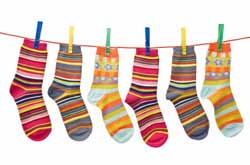 Socks for Diabetics, really? Who knew you needed special diabetes socks? I will briefly take a look at why special socks are needed. Then, we will jump into the Top 10 Factors for choosing the right ones. Finally, I will finish off with some of the top brands to locations to purchase.
Socks for Diabetics, really? Who knew you needed special diabetes socks? I will briefly take a look at why special socks are needed. Then, we will jump into the Top 10 Factors for choosing the right ones. Finally, I will finish off with some of the top brands to locations to purchase.
There are a variety of reasons why diabetics need special foot protection. The main reason is that 60-70 percent of diabetics develop some form of neuropathy in their feet. Essentially, the elevated level of blood sugar causes damage to your nerves, most often in the feet or legs, although it can occur in other locations as well.
If your nerves are damaged, then you can’t feel what I going on with your feet. Also, the elevated blood sugar can cause decreased blood flow to your feet, slowing the healing process. Thus, small things can easily become much bigger problems. That blister or small cut, can easily become infected and very hard to heal.
So, where do the socks fit in? You want socks that don’t do any damage to your feet. For example, they should be too tight or have heavy seems on them that can cause blisters. They also need to keep moisture away from your feet so the risk of infections is reduced.
TOP 10 FACTORS
These factors are not in any particular order of importance. Also, even if you choose the perfect sock, make sure you through them away if they get any holes in them or become worn.
- Fit: You want socks that fit. They should not be too tight, which can cause circulation and other problems. Likewise, they should not be too big, since these can cause blisters.
- Clean: Okay, messy Marvin, make sure you put on clean socks daily. If your socks are soiled then they can more easily cause infections.
- Dry: You want socks that keep your feet dry. If your feet are damp or moist, then fungus can more easily grow. This factor overlaps a variety of other factors, such as the material you choose.
- Thickness: Try and avoid a very bulky sock. Obviously, if you are going snowshoeing, you want a thick sock that can keep you warm. However, bulky socks can cause extra moisture and/or can cause bunching, which can lead to blisters, etc. Try and balance your activity level with the appropriate socks for diabetics.
- Shape: Square toes work best because they won’t squeeze your toes.
- Elastic Tops: Some socks have very tight elastic tops. Obviously, you want socks to stay up, but socks for diabetics need to not squeeze your calves/ankles too much. Many diabetic socks have a special weave on the top to keep the sock up without unduly squeezing your leg.
- Seams: The less seams the better. Large seams can cause your feet to rub unnecessarily, leading to injuries.
- Color: If at all possible, where light colored socks, so you can see if any injuries have occurred.
- Cushion Sole: As stated above, you want to avoid bulky socks. However, a little extra cushion on the sole of the sock can be helpful. As we get, ahem, older, the soles of our feet become more sensitive.
- Material: This is the big issue for diabetic socks. Some folks say man made material is better, such as acrylic. Other folks say natural material is best, such as cotton or wool. Let’s take a look at each material:
Acrylic: Some argue that man made material will wick moisture away from your skin better than some materials, most notably cotton.
Cotton: Thick cotton is probably not the best, as it will trap moisture. Also, if you live in a cold climate, the moisture that is trapped in the cotton can cause your feet to get really cold, which you will not feel as much, or at all, if you have neuropathy. Thin cotton socks can be good if you live in a warmer climate or are working out.
Wool: Wool is great for keeping your feet warm and wicking moisture. If you live in a cold climate, these socks are great. Even if you live in a warmer climate, you should investigate thin wool socks to see if they work for you.
Blended: Cotton-wool blend or a synthetic-natural material blend can also be good depending upon your circumstances.
Bottom line is that the material you choose will have a lot to do with what you are doing and the climate you are doing it in when chosing socks for diabetics.
WERE AND WHAT SOCKS FOR DIABETES TO BUY
First, I am not aware of any study that says you have to buy a particular brand of socks or even a sock that is made specifically for diabetics. So, if you find a sock that matches up with the above. Don’t be afraid to buy it, even if they are not branded as socks for diabetics.
I will say that the Dr. Sholls diabetic socks are very popular. However, other top brands are as well. Here are some links for some top brands that can be had at a discount:
SOURCES:
Informal Diabetic Foot Study (accessed May 2012)
American Orthopaedic Foot and Ankle Society,The Diabetic Foot (accessed May 2012)
